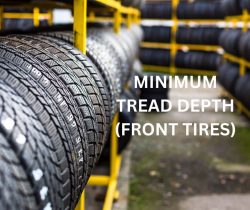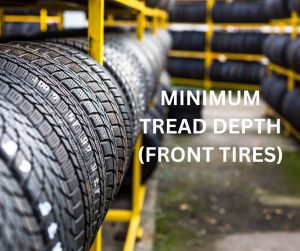Houston Car Accident Lawyers > Articles > Vehicle Safety > Analysis of the Minimum Tread Depth for Front Tires
Analysis of the Minimum Tread Depth for Front Tires

Tread depth is an important factor in determining how well your tires will grip the road. In general, front tires need a minimum tread depth of 4/32nds of an inch to provide adequate traction. However, factors such as driving conditions and tire type can impact this figure. Be sure to consult your owner’s manual or tire manufacturer to get the specific recommendation for your vehicle.
If you’ve been injured in an auto accident, then call our Houston Truck Accident Attorneys.
How Many MM of Tread is Good
The minimum tread depth for front tires is 4/32 of an inch.
For vehicle owners, it’s essential to be aware of the minimum tread depth required for front tires, which is 4/32 of an inch. This is a critical measure when it comes to safety since properly-operated tires with adequate tread can help maintain traction and control on the road.
Over time, tire treads wear down, so having your tires frequently checked—at least yearly—is recommended in order to ensure that the necessary minimum requirement is met. When tires may need replacing due to worn treads or other damage, there are several considerations aside from just tending to the minimum 4/32 of an inch required for front tires such as budget and performance requirements for your driving needs.
Front Tire Tread Depth
This is the equivalent of 1.6 millimeters or about the thickness of a penny.
 We often take the thickness of a penny for granted, but in reality it can be incredibly useful for measuring minuscule points. It may not seem like much, but the equivalent of 1.6 millimeters can be used to measure extremely small items with accuracy and precision.
We often take the thickness of a penny for granted, but in reality it can be incredibly useful for measuring minuscule points. It may not seem like much, but the equivalent of 1.6 millimeters can be used to measure extremely small items with accuracy and precision.
For example, technicians in electronics repair often rely on measurements of this magnitude on a daily basis to ensure that the most minute details are accounted for in their work. If you ever find yourself needing to make such measurements, remember that the thickness of a penny is all it takes!
Steer Tire Tread Depth
Tractor Trailer Tire Tread Depth
Tires with less than this amount of tread are considered bald and need to be replaced.
Even experienced drivers may not realize the importance of tread depth on their tires. Industry standards suggest that tires should be replaced when the tread depth is below 2/32”, as tires with less than this amount are considered “bald.”
While bald tires still pass a visual inspection, they pose a greater risk to the driver and other road users because of decreased traction and braking performance. To keep your family safe, it’s important to regularly check your tread depth and consider replacing any tire that falls below 2/32”.
If you’re not sure how much tread is on your tires, you can check by inserting a penny into the tire’s groove.
Keeping your vehicle’s tires in good condition means paying attention to their tread depth. If you’re not sure if the tire needs replacing or not, there is an easy method to check. Simply take a penny, turn it upside down, and insert it into the tire’s groove.
If you can see above Lincoln’s head, that means that the tread is below 2/32 of an inch and replacement is recommended. Make sure to inspect all four tires regularly throughout the year for best performance and safety on the road.
If you can see all of Lincoln’s head, then your tread depth is less than 4/32
One way to determine your tire tread depth is simply by using a penny. Insert the penny into one of the grooves of your tire, Lincoln’s head facing inward. If you can see all of Lincoln’s head, that means your tread depth is at 4/32 or less.
Tread depths below this are illegal in some states and could impair your vehicle’s performance and handling, as well as increase stopping distance by up to 21%. Regularly checking and replacing worn tires will ensure that you remain safe while driving, no matter what the state requirements are.
When To Replace Tires
As a vehicle owner, it is important that you take proper care of your car by keeping up with regular maintenance. One of the key areas to focus on is the tires since they are crucial for both safety and performance. Make sure to inspect your tires for wear and tear periodically and replace them before they become too damaged and unsafe to drive on.
Take the time now to check your tires and ensure that your vehicle remains reliable and safe in all road conditions.
Being aware of your tire tread depth and how to check it is important for the safety of you and those around you on the roads. Even though the legal minimum tire tread depth in the US is 4/32 of an inch, which is roughly the thickness of one penny, many suggest shopping for tires with a deeper tread depth.
This added tread helps provide additional grip on wet and slick roads and can help reduce aquaplaning. So next time you’re driving, take a moment to consider your own tire’s condition and make sure they are still safe to drive on. Spending a few extra minutes on vehicle maintenance now could make all the difference down the road!
